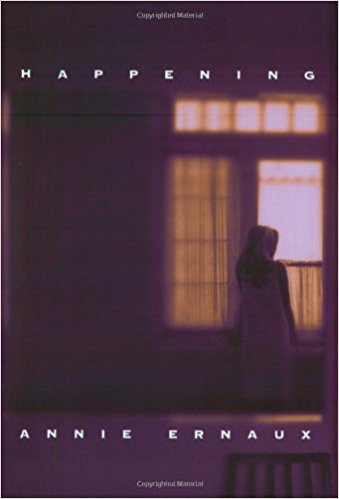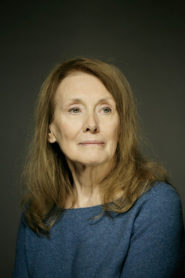Writers Read: Happening by Annie Ernaux
 Near the end of her abortion memoir Annie Ernaux writes, “…these things happened to me so that I might recount them. Maybe the true purpose of my life is for my body, my sensations and my thoughts to become writing, …causing my existence to merge into the lives and heads of other people” (92).
Near the end of her abortion memoir Annie Ernaux writes, “…these things happened to me so that I might recount them. Maybe the true purpose of my life is for my body, my sensations and my thoughts to become writing, …causing my existence to merge into the lives and heads of other people” (92).
Not only does Ernaux tell the story of her abortion, she commits herself to “revisit every single image…” from that experience (20). Like a film, the memoir plays for us frame by frame so we not only find out what happened to her, but also see what she saw as each step of this process unfolded in her life.
Indeed, Happening is a highly visual memoir. From the pink shopping bags on the opening page, to the wash basin in the abortionist’s apartment and the black tights she wears after she recovers, Ernaux gives us detail after detail to make her writing come off the page.
This allows us to feel as though we are reading about this experience in real time, rather than as a recollection. Ernaux doesn’t write, “this is how I remember it.” She writes “this is exactly how it was.” And we are there with her.
Most vivid is the unflinching way in which Ernaux describes the moments of crouching on the bathroom floor to deliver her aborted fetus. “It burst forth like a grenade, in a spray of water that splashed the door. I saw a baby doll dangling from my loins at the end of a reddish cord” (74).
The fetus’ expulsion from Ernaux’s body is violent, gruesome and painful. However, instead of propelling her into shame and regret, Ernaux finds herself a new person, a person who has delivered a baby and in doing so has joined the heritage of all other women who have also delivered. It’s a right of passage into womanhood.
This made me think how perfect her choice of a title for this work is. “Happening” means, of course, that Ernaux conveys something significant that happened, but also that this transformation is something that is always “happening” to women every day. It makes the story universal, not only extending it from Ernaux’s personal experience to every woman, but also from the 1960’s to now.
Interestingly, at the end of the memoir Ernaux writes of trying to recreate part of her abortion experience by going once again to Paris to find the abortionist’s apartment and to see the café where she waited with a cup of tea. As she looks for the café we read, “From the outside, none of them looked familiar but I was sure I would recognize the downstairs bathroom” (94). She goes inside a place she thinks might be the right one but doesn’t recognize the bathroom. She concludes it looks like all the other bathrooms from that time.
Memory is a layered and uncertain phenomenon. Ernaux sees the pink shopping bags across many years of memory, but in the present day she can’t recognize a bathroom. Should we infer that it is only selective details which remain over time and can be written about? Is there any way to know which memories are reliably accurate and which are not?
Perhaps the most important question is whether it actually matters. That Ernaux doesn’t recognize the café bathroom thirty years after first seeing it in no way detracts from the power of the memories she recounts. Would this story be more compelling if she had felt the flash of recognition as she stepped into the bathroom? What’s important is that the emotional echoes of the experience continue to sound, like the vibrations of a tuning fork, through her life.
As a fiction writer the accuracy of memory may matter differently to me than it would to someone, such as Ernaux, writing memoir. What is most significant to me as I plumb the depths of my memories is that I capture the feelings they impart so I can pass them on to my characters.
For example, I recently wrote a scene in which an adult character visits a fun fair she attended with her parents as a child. I have  never had this exact experience; I have no exact equivalent memory on which to draw to describe the scene.
never had this exact experience; I have no exact equivalent memory on which to draw to describe the scene.
I have, however, had many other experiences of nostalgia. I can think of these to remember details of sensory experiences and feelings that capture how it feels to revisit an important place years after last seeing it. It’s not the accuracy of the memory or the imagery that matters but rather the emotional residue, the feelings that weave through the events and images.
What Ernaux writes about her memoir is equally true for me as a writer of fiction. Because I can also re-create the most resonate emotional threads of my own experiences through my characters I could also say, “ …the true purpose of my life is for my body, my sensations and my thoughts to become writing, …”
Ernaux, Annie, Happening, New York: Seven Stories Press, 2000. Print.





